Stanley Kubrick’s 1980 masterpiece is full of doubles, doppelgängers, and alter-egos.

Mirrors, ghosts, doppelgängers, reflective surfaces, repetitions, and perfectly symmetrical frames…these are just a few cinematic devices which Stanley Kubrick uses to create an uncanny atmosphere in his 1980 adaptation of Stephen King’s The Shining. Sigmund Freud defines the term “uncanny” in his essay “‘The Uncanny’” as something which is familiar yet somehow frightening. The Shining tells the story of a family of three — Jack (Jack Nicholson), Danny (Danny Lloyd), and Wendy (Shelley Duvall) — whose lives are terrifyingly disrupted when they move into the Overlook Hotel for the winter. Family is, by definition, the most familial subject matter, and therefore it is all the more terrifying when one’s family members somehow seem different. The Shining is filled with uncanny doubles, where those who look or act familiar are mysteriously different, which provoke feelings of terror. Kubrick creates this uncanny atmosphere by meticulously crafting a story-world filled with doubles, doppelgängers, alter-egos, and mirrors.
Cinema is the perfect medium for dealing with themes of doubles and doppelgängers. First of all, it is a visual medium involving moving images, which allows for a unique visualization of its subject matter. Audiences can see, rather than just imagine, what characters, events, and places look like. Secondly, film cameras (or digital cameras) pick up immense amounts of detail, therefore filmmakers can insert small changes across shots that are just noticeable enough to be off-putting. Films are typically 90–120 minutes long — short enough that audiences are likely to notice these small changes, but long enough that audiences may not be able to tell exactly what has changed. Most importantly, film itself is a double of the world it represents onscreen. The actors appearing onscreen are doubles of their real-world equivalents. Audiences may sometimes get an uncanny feeling while watching films, because the actors are not real people present in the theater, but are merely their photographic doubles. This adds another layer of doubling to films which already deal with doubles and doppelgängers, such as The Shining.
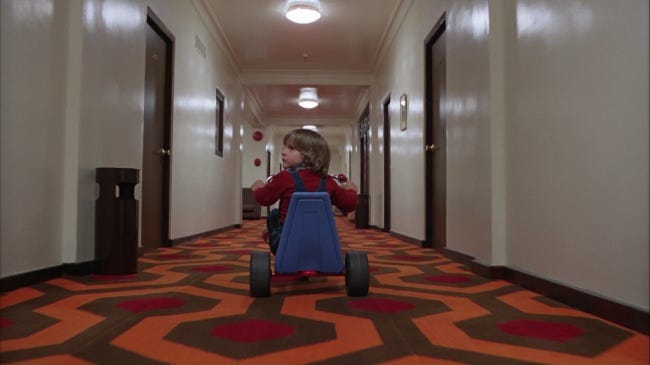
Freud also notes that with doubling “there is a dividing, and interchanging of the self,” and this is especially true with actors portraying characters onscreen. They become another person — a double of themselves — when they act in films. One may recognize the actor onscreen, but the actor is not themself, because they are embodying a character, possibly with opposing traits to their public persona. This can be uncanny or jarring for audiences, because the actor may seem familiar, but they are somehow different since they are embodying someone else.
Doubling is also essential to Freud’s concept of the uncanny. Freud notes that characters in fiction are considered doubles when they are identical in appearance, and this doubling also frequently involves characters sharing mental processes — such as thoughts, emotions, and experiences — telepathically or otherwise. Characters’ identities come into question when they confront their doubles, and they may end up taking on their doubles’ identity, according to Freud’s observations. Freud also believes that uncanny feelings are aroused by constant recurrences of the same thing — for example, a repeated phrase (“all work and no play…”) — when the same character traits occur in multiple people, or when the same crimes are committed across multiple generations. Repetitions are especially uncanny in that the same situation may occur, but with certain details changed — the situation is familiar, but with enough differences to produce a feeling of fear or uncertainty.
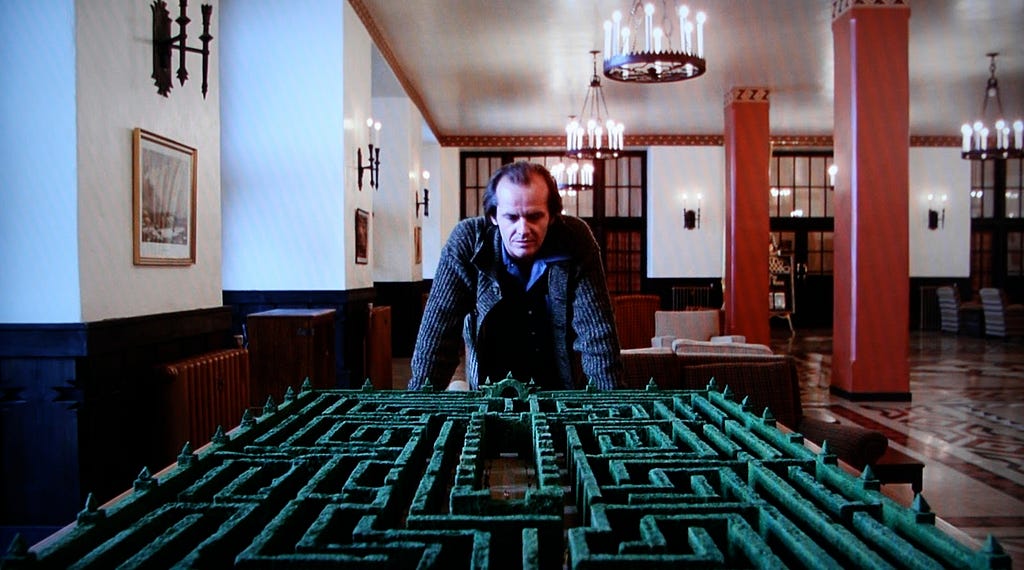
Freud notes that the uncanny is frequently experienced in relation to death, dead bodies, and the return of the dead — for example, ghosts and spirits. The Shining is essentially a ghost story. Freud writes that ghosts and spirits produce an uncanny feeling because they are the return of what is thought to be dead and gone. Ghosts are also doubles of people who were once living. In The Shining, ghosts appear frequently and provoke uncanny feelings, especially because one cannot tell who is alive and who is dead in this film. At various points, each member of the Torrance family has an uncanny experience with ghosts.
At the beginning of the film, hotel manager Stuart Ullman (Barry Nelson) recounts the story of how the Overlook Hotel’s ex-caretaker, Charles Grady, murdered his wife and two daughters before committing suicide. It can then be concluded that when Danny has visions of two little girls in blue dresses, they are the ghosts of the Grady sisters (the beautiful and brilliant Lisa and Louise Burns). They are the ghosts who appear most frequently in The Shining: first when Danny has a vision in the bathroom while brushing his teeth, then when he plays darts in the Overlook’s “games room,” and later when he rides his tricycle through the hotel. These ghosts are particularly uncanny because they are not only doubles of their past (living) selves, but they are identical twins — doubles of each other. Margot Blankier writes in The Irish Journal of Gothic and Horror Studies that the uncanny visual iconography of the film is heightened by the shots of the twins, who appear to be perfect doubles of each other, despite hotel manager Stuart Ullman’s previous claim that they were two years apart.
The Grady sisters’ most terrifying appearance is when Danny encounters them standing at the end of the hotel corridor while he sits on his tricycle. Their ghostly voices echo as they invite Danny to “come play with us… forever and ever and ever…” and Danny has visions of their bloody bodies lying in the hallway where they currently stand. This sequence portrays images of the ghostly twins, as well as images of their violent and brutal deaths. The dualities of living/dead, ghosts/girls, and sister 1/sister 2 are so uncanny that all Danny can do is cover his eyes with his hands.
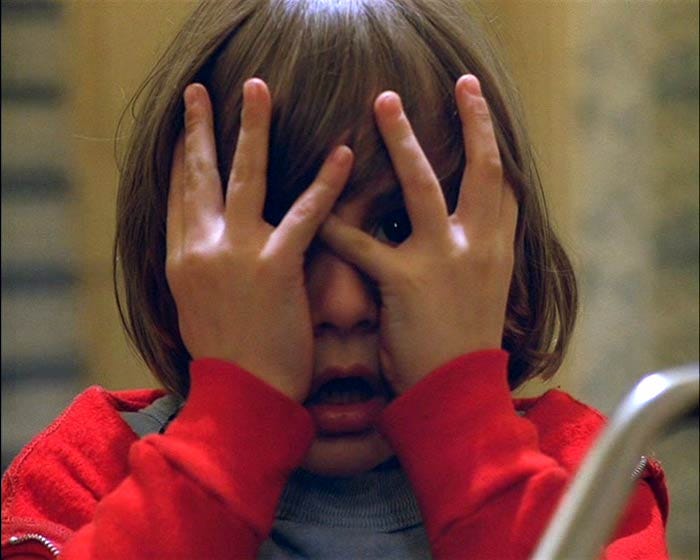
Blankier also writes that doubles come in the form of alter-egos in The Shining. Jack’s alter-ego(s) are ghostly and violent, whereas Danny’s protect him by giving him knowledge about unpleasant aspects or events in his life. Wendy tells the doctor in Colorado that Danny started talking to his imaginary friend “Tony” three years prior, when Jack accidentally dislocated Danny’s shoulder. Tony’s appearance is signaled onscreen by Danny speaking in a different, more high-pitched voice, and wagging his index figure in time with his speech. Tony is Danny’s double, and represents Freud’s “division of the self.”
Tony is particularly uncanny because he provides Danny with information which, by all natural laws, he has no way of knowing. For example, when Danny brushes his teeth in the Colorado apartment, Tony informs him that Jack has gotten the job at the Overlook and prompts visions of violent images in Danny’s mind — such as shots of the Grady twins, and blood rushing down the elevator corridor of the hotel. These images are so terrifying and inexplicable that Danny passes out in fear. Blankier writes that Danny surrenders to the hallucinatory demands of his double, who inserts horrifying images into his head. The framing of the scene portrays Danny looking at himself in the mirror, having a conversation with Tony, and alternating between his two voices. The way Kubrick frames Danny in the mirror highlights the fact that Tony is Danny’s double — he is the inverse image of Danny. Tony is Danny, but slightly altered and supernatural, creating an uncanny feeling.
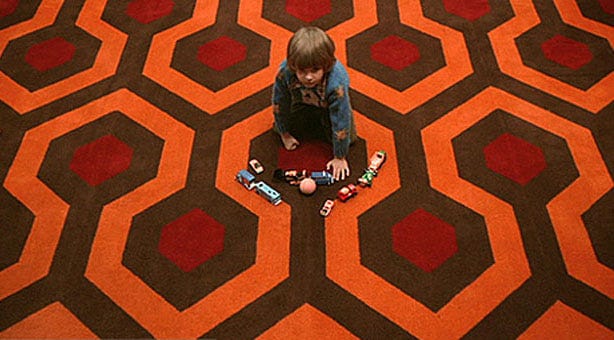
Danny’s alter-ego is part of him, but Jack’s is externalized and ghostly. Blankier notes that Jack, similar to Danny, also experiences a dual nature within himself — he struggles between his murderous impulses and being a loving, supportive father and husband. Blankier also points out that Danny and Jack form an opposing pair in how they deal with the Overlook’s monstrous influence. Jack surrenders to the ghostly forces of the Overlook, but Danny displays incredible strength when he breaks free from the Overlook’s power and escapes with Wendy.
Blankier posits that Jack has more than one double: he has Lloyd the bartender (Joe Turkel) — his “evil guardian” — and Delbert Grady (Philip Stone), his alter-ego from the past. Thomas Allan Nelson writes in his book Kubrick: Inside a Film Artist’s Maze that Kubrick was fascinated by the idea that monsters exist in the shadow of one’s self, and he frequently used the device of physical and psychological doubles to display this. Once Jack is in the Overlook, it seems his shadow self starts to take over, represented by a number of uncanny doubles. Nelson notes that even Jack’s doubles seem to have doubles — Delbert Grady, the waiter/butler, is different from Charles Grady, the previous caretaker Ullman previously mentioned. There are two Grady sisters, and seemingly two Grady fathers — both of which are Jack’s doubles/alter-egos.
Jack’s doubles are uncanny because they appear onscreen despite having died many years ago. The Torrance’s are supposed to be the only people in the hotel, yet Lloyd and Grady appear, as well as a stream of party guests in the Gold Ballroom. Jack’s ghostly doubles are not identical to him in appearance, although they are similar — Lloyd wears a maroon jacket similar to Jack’s, and this costume choice, as well as the editing of the scene, gives the appearance that they are doubles. There are mirrors behind the bar in the Gold Room, and the scene is edited using shot-reverse-shot, making it look as though Jack is talking into a mirror. Later in the film when Jack encounters Delbert Grady, the men have a conversation in a striking red bathroom, which is edited in a very similar way.
Nelson writes that Grady is a more sinister version of Lloyd, because while they are similar in that they are both ghostly employees of the Overlook, Grady is sinister and violent, having “corrected” (murdered) his wife and children. The editing and set design of the red bathroom create a sense of the uncanny. Philip Kuberski notes in his article “Plumbing the Abyss: Stanley Kubrick’s Bathrooms” (yes, really) that Jack’s eyes frequently dart towards the long mirrors running along the side of the red bathroom, furthering the appearance that he is talking to himself. It is unnerving when Grady informs Jack that he has “always been” in the hotel, and claims that Jack has always been there, too — this recalls Jack’s earlier statement that he felt a strong sense of deja vu when he first entered the Overlook. This also recalls Freud’s statement that the uncanny includes repetitions of past crimes, names, and faces across generations with only slight changes.
Nelson notes that the film contains four bathrooms, each of which involve scenes of uncanny doubling. The bathroom at the Torrance’s Colorado apartment is where Danny speaks to Tony in the mirror, and the red bathroom is where Jack has his chilling conversation with Grady. There is also the bathroom in the Torrance’s Overlook apartment, which Jack first describes as “homey,” then later breaks into using an axe while trying to kill Danny and Wendy (“Heeeere’s Johnny!”). Perhaps the most uncanny location in the entire film is the green bathroom in room 237, where Jack and Danny each encounter the same ghostly and terrifying woman. Danny’s visit to room 237 is not visualized, but he tells Wendy he was strangled by a “crazy woman,” and there are bruises on his neck. Jack goes into the room to investigate, and when he approaches the bathroom, a nude young woman appears from behind the shower curtain. She approaches Jack seductively and he embraces her, but moments later he looks at the mirror behind her and she is actually a decomposing old woman.
This is another instance of ghostly doubling: there are two versions of the same woman in the bathroom, who is likely the ghost of someone who died in the Overlook. The doubling in this scene is once again highlighted by a mirror — Jack could not see the ghost’s alternate identity until he looked in the mirror. The ghosts in The Shining are uncanny in themselves, but even more terrifying due to the fact that they are frequently doubled: there are two Grady sisters, Delbert is a more menacing version of Lloyd, and the woman in room 237 has two different bodies.
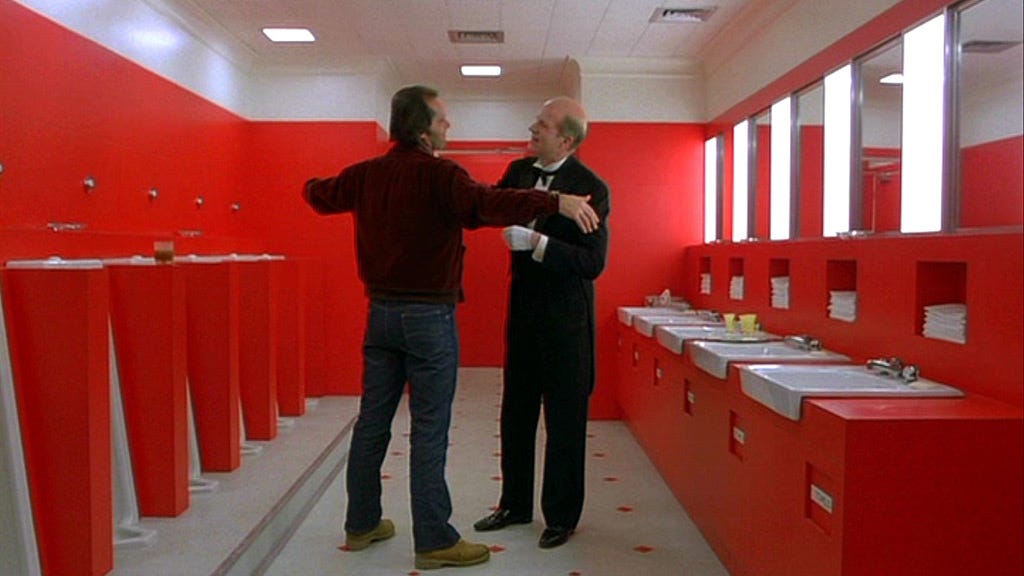
Robert Kolker writes that the film also features many instances of symmetrical framing. He notes that each side of the frame is doubled and perfectly composed, and therefore any horrific event happening within the frame seems even more out of place and strange. The symmetrical shots are almost too perfect, which can be uncanny and off-putting in itself. Kolker cites the red bathroom as an example of a symmetrically framed scene, with its rows of white urinals and sinks lining either side of the wall and the long mirrors running along the wall. The bathroom is symmetrical, yet Jack and Grady discuss violent, murderous plans in the middle of the room, throwing the symmetry off balance and into uncanny space.
The same effect appears in Dick Hallorann’s (Scatman Crothers) Florida bedroom: the room is symmetrical with two portraits of nude women on either side of the room, and one lamp on either side of the television. Within this carefully composed image, Hallorann lies in bed and receives telepathic information from Danny, indicating that the Torrance’s are in terrible trouble. The perfectly composed image is thrown off balance, as something sinister and supernatural is taking place within it.
I have outlined a number of instances of doubling within The Shining, but I am sure that if one kept looking, there are even more examples. Not to mention, doubling is a persistent theme across Kubrick’s filmography — symmetry, doubles, and mirrors can be found in A Clockwork Orange, Eyes Wide Shut, Barry Lyndon, and Full Metal Jacket. Kubrick had a masterful understanding of how to utilize cinematic techniques to create meticulous images and terrifying atmospheres, particularly pertaining to the subject of doubles. The final image of The Shining shows Jack smiling out from a photograph taken in 1921 — one cannot be sure whether this is Jack himself, or one of his uncanny and ghostly doubles. There are no stable conclusions about the Overlook, but one thing is certain — doubles and doppelgängers are things of terror, as Freud once wrote.
Forever and Ever and Ever: Uncanny Doubles in ‘The Shining’ was originally published in Film School Rejects on Medium, where people are continuing the conversation by highlighting and responding to this story.